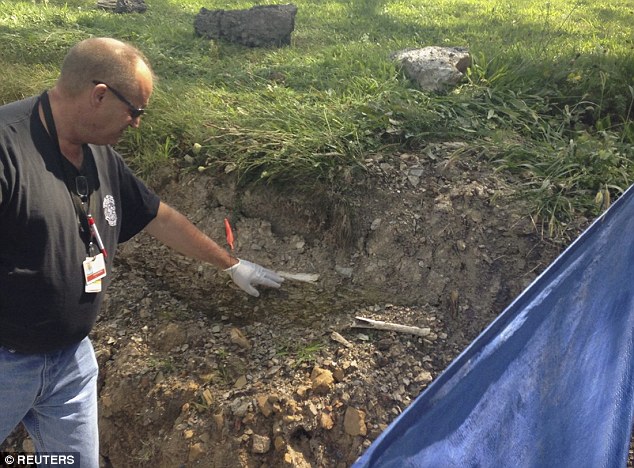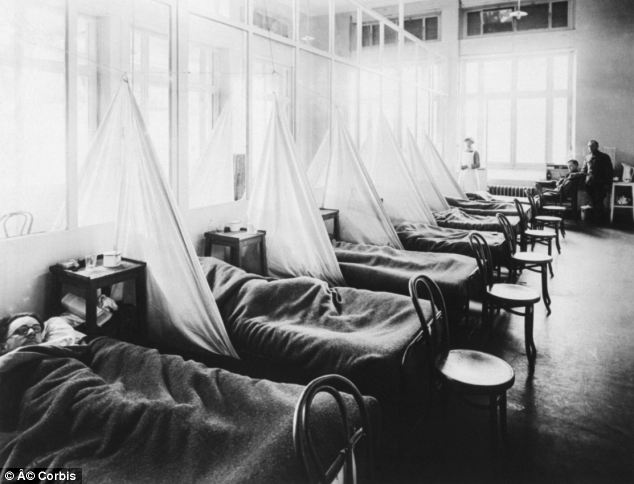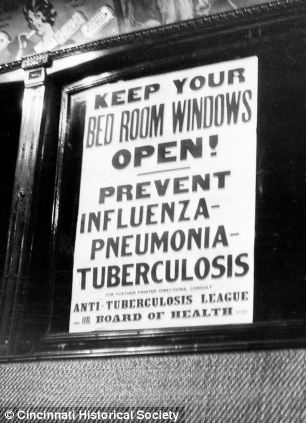
- Experts say it is 'unlikely' the site still has active pathogens
- Bones of impoverished victims found under highway embankment
- Believed impromptu burial site once been the site of a poorhouse
- Experts say it could contain a mass grave for victims
The state highway department, known as PennDOT, received reports of bones in what appeared to be an impromptu burial site beneath a broad meadow that had once been the site of a poorhouse, said Bob Rescorla, a PennDOT inspector at the site.
Researchers are now looking for more bones believed to be from impoverished victims of the worldwide Spanish flu pandemic in 1918.
The state highway department, known as PennDOT, received reports of bones in what appeared to be an impromptu burial site beneath a broad meadow that had once been the site of a poorhouse, said Bob Rescorla, a PennDOT inspector at the site.
'There were rumors it was a mass grave here,' Rescorla said of the burial ground along State Highway 61 in Schuylkill Haven, about 100 miles northwest of Philadelphia. Historians say the Spanish flu pandemic touched all parts of the world and claimed tens of millions of lives. The flu could kill quickly, sometimes in less than a day.
In Schuylkill County, the Pottsville Republican-Herald newspaper reported that some 17,000 residents were sickened and several thousand died during the pandemic, leaving as many as 3,000 children orphaned.
PennDOT workers had shaved the embankment for a road widening project earlier in the week, Rescorla said, and heavy rains later caused part of the cut to collapse, exposing bones.
Kevin Mock, an archaeologist with PennDOT, told Reuters on Friday he could see leg bones and part of a jaw bone protruding from the embankment. He said there were no coffins.

He thought it unlikely there could still be active H1N1 flu pathogens - the strain that caused the 1918 pandemic - in the bones or soil given the passage of time and the usual practice of sprinkling lye over buried without coffins.
In particular, Mr Gates fears a Spanish flu-like epidemic similar to the one that killed more than 65 million people in 1918 could decimate populations in a matter of months. In this image, patients of the Spanish flu lie in Influenza Ward No. 1 in a French hospital as doctors battled the virus and the effects of the War
A team of professors and students from Mercyhurst University in Erie, Pennsylvania, arrived at the site on Friday afternoon along with the Schuylkill County Coroner's Office and cadaver dogs.
The Mercyhurst team set up a sieve for screening soil for bone fragments, and marked visible bone fragments protruding from the embankment with small red flags.
Dr. David Moylan, the Schuylkill County coroner, said the team would not excavate the entire field, but will remove remains near the highway.
They will be taken to Mercyhurst University for medical examination and possible DNA extraction.
After that, Moylan said, they will be cremated and buried in a modern cemetery for the unidentified or unclaimed maintained by the county.
The 1918 Flu Outbreak - The Worst The World Has Ever SeenSource: Reuters
Lacking a reliable cure, public health groups concentrated on prevention
The deadly flu virus attacked more than one-third of the world's population, and within months had killed more than 65 million people - three times as many as the World War I - and did it more quickly than any other illness in recorded history.
Most influenza outbreaks disproportionately kill juvenile, elderly, or already weakened patients; in contrast the 1918 pandemic predominantly killed previously healthy young adults.
To maintain morale, wartime censors minimized early reports of illness and mortality in Germany, Britain, France, and the United States.
However, newspapers were free to report the epidemic's effects in Spain, creating a false impression of Spain as being especially hard hit - and leading to the pandemic's nickname Spanish flu.
The close quarters and massive troop movements of World War I hastened the pandemic and probably both increased transmission and augmented mutation, researchers believe.
The global mortality rate from the 1918/1919 pandemic is not known, but an estimated 10% to 20% of those who were infected died, with estimates of the total number of deaths ranging from 50 to 100 million people.




"unlikely'?? Perhaps so, but then the govt says that about everything potentially dangerous, from bad economic news to bad vaccines, bad education policies, et al. Seems these type of sites are rising from the graves all over the world. Another sign of our times perhaps?